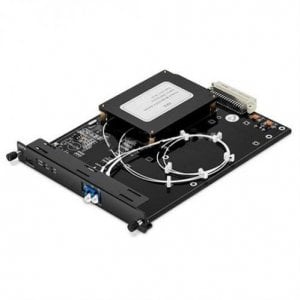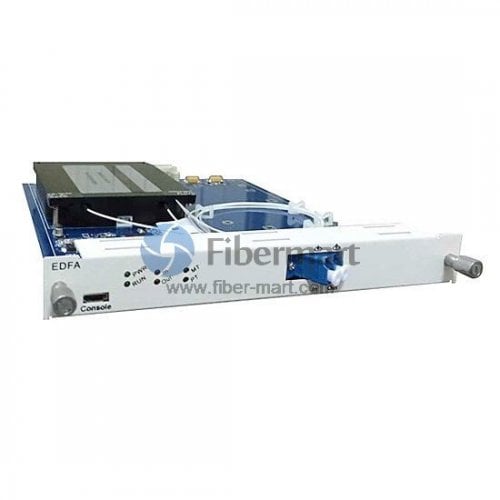Explore how EDFAs act as lifelines for data amplifying weak signals and ensuring they travel long distances without succumbing to signal loss.
Fiber optic networks, with their incredible speed and capacity, have become the backbone of the information superhighway, supporting everything from high-speed internet to global telecommunications. However, as data travels over long distances through these networks, signal strength diminishes, leading to potential data loss and communication breakdowns.

The Challenge of Signal Degradation
Imagine sending a message down a long, dark hallway. By the time it reaches the other end, the message might be faint or distorted. Similarly, light signals traveling through fiber optic cables experience attenuation. This happens because of several factors:
Absorption: A small portion of the light signal is absorbed by the fiber optic material itself.
Scattering: As the light travels, it bounces off microscopic imperfections in the fiber, causing it to deviate from its path and lose energy.
Bending Losses: When a fiber optic cable bends sharply, it can cause light to leak out, further weakening the signal.
The combined effect of these factors is a gradual decrease in signal strength, particularly for long-haul fiber optic networks that span hundreds or even thousands of kilometers. Without intervention, the signal can become too weak to be detected accurately by the receiving equipment, leading to data errors and loss of communication.
Enter the EDFA: The Signal Amplifier
To address the issue of signal attenuation, EDFAs are deployed at intervals along the fiber optic route. An EDFA is a type of optical amplifier that boosts the strength of the light signal without converting it to an electrical signal. This capability is essential for maintaining high-speed data transmission over long distances.
Here's how it works. EDFAs leverage the unique properties of erbium, a rare-earth element. When doped into the core of a silica fiber and pumped with light from a laser diode, erbium ions can amplify light signals in the 1550 nm wavelength region, which is commonly used in fiber optic communications due to its low loss and dispersion characteristics.
Advantages of EDFAs: Why They Rule the Long Haul
Transparency: Unlike some amplifiers that operate on specific wavelengths, EDFAs are wavelength-agnostic. They can amplify a broad spectrum of light signals, making them compatible with various data transmission formats. This is crucial because fiber optic systems often employ multiple wavelengths to carry information.
High Gain and Low Noise: EDFAs provide high gain, typically ranging from 20 to 40 dB, which is sufficient to compensate for significant signal attenuation. Additionally, they exhibit low noise figures, meaning they introduce minimal additional noise to the signal. This high gain-to-noise ratio is critical for maintaining signal quality over long distances.
Scalability: Long-distance fiber optic links can stretch for hundreds or even thousands of kilometers. A single EDFA might not be enough to compensate for the total signal attenuation. The beauty of EDFAs lies in their modularity.
Multiple EDFAs can be cascaded along a fiber optic link, acting like booster stations. Each EDFA amplifies the signal, effectively passing the baton to the next one, allowing data to travel even greater distances without degradation.
WDM Compatibility: Wavelength-Division Multiplexing (WDM) is a game-changer in fiber optic communication. It allows for transmitting multiple data streams simultaneously on a single fiber by using different wavelengths of light.
Here's where EDFAs shine again. They efficiently amplify all these separate channels without introducing crosstalk, a phenomenon where signals from different wavelengths interfere with each other. This ensures clear and independent transmission of each data stream.
Broadband Operation: EDFAs operate over a broad range of wavelengths in the C-band (1530 nm to 1565 nm) and L-band (1570 nm to 1610 nm). This broad operational range makes them versatile and suitable for various network configurations and applications, including long-haul and metro networks.
Reliability and Longevity: EDFAs have proven to be highly reliable with long operational lifespans, often exceeding decades. Their solid-state nature, combined with minimal moving parts, reduces the likelihood of mechanical failures, ensuring consistent performance and reducing maintenance costs.
Different Types of EDFAs for Diverse Needs

Pre-Amplifiers
Pre-amplifiers, or pre-EDFAs, are designed to amplify weak signals at the receiving end of an optical link before they are processed by the receiver. These amplifiers are crucial in situations where the incoming signal has suffered significant attenuation and noise, making it difficult to discern without initial amplification.
Applications
Optical receivers in long-haul communication: Pre-EDFAs boost weak signals received after long-distance transmission, improving the sensitivity and performance of the optical receiver.
In scenarios requiring the detection of extremely low-power signals, such as in scientific research or certain defense applications, pre-amplifiers ensure the signal is sufficiently amplified for accurate analysis.
Booster Amplifiers
Booster amplifiers, also known as power amplifiers, are placed at the transmitting end of an optical link. Their primary function is to increase the power of the optical signal before it enters the fiber, ensuring that the signal can travel longer distances without significant attenuation.
Applications
Transmitter end in long-haul networks: Booster EDFAs enhance the launch power of signals in long-haul communication systems, enabling the signal to reach distant receivers with adequate strength.
In networks where high data rates and long distances are involved, booster amplifiers provide the necessary signal strength to maintain data integrity and performance.

In-Line Amplifiers
In-line amplifiers are strategically placed along the optical fiber route to periodically boost the signal strength as it travels through the network. These amplifiers are essential for maintaining signal integrity over very long distances.
Applications
Long-haul and ultra-long-haul networks: In-line EDFAs are critical in long-distance communication links, such as undersea cables and terrestrial long-haul networks, where signals need regular amplification to counteract attenuation.
Extended reach in metro networks: In metro networks with extended reach, in-line amplifiers ensure that signals maintain adequate power levels throughout the transmission path.
Metro EDFAs
Metro EDFAs are specifically designed for metropolitan area networks (MANs), where the transmission distances are shorter, but the demand for high capacity and density is high. These amplifiers are optimized for the unique requirements of metro networks, such as supporting multiple wavelengths and handling high data traffic volumes.
Applications
Metro EDFAs support DWDM systems, enabling multiple high-capacity channels to be transmitted simultaneously over shorter distances within metropolitan areas.
Intra-city data center connections benefit from metro EDFAs, ensuring high-speed data transfer with minimal latency.
Hybrid EDFAs
Hybrid EDFAs combine the erbium-doped fiber amplification with other amplification technologies, such as Raman amplification. This combination enhances the overall performance, providing higher gain, broader bandwidth, and improved noise performance.
Applications
Hybrid amplifiers are used in advanced optical networks requiring superior performance, such as national backbone networks and research and education networks.
In systems with complex configurations and demanding performance criteria, hybrid EDFAs offer a versatile solution by leveraging the strengths of multiple amplification techniques.
L-Band EDFAs
While standard EDFAs operate primarily in the C-band (1530 nm to 1565 nm), L-band EDFAs extend the amplification range to the L-band (1570 nm to 1610 nm). This extension allows for additional wavelength channels, increasing the overall capacity of the fiber optic network.
Applications
Capacity expansion: L-band EDFAs are employed in networks that require additional bandwidth, enabling the use of more wavelength channels and thus increasing data transmission capacity.
Future-proofing networks: By utilizing both C-band and L-band EDFAs, network operators can future-proof their infrastructure, accommodating future growth in data traffic.

Gain-Flattened EDFAs
Gain-flattened EDFAs are engineered to provide uniform gain across a broad range of wavelengths. This uniformity is crucial in WDM systems to ensure that all channels receive equal amplification, maintaining signal quality and balance across the spectrum.
Applications
WDM systems: In WDM systems, gain-flattened EDFAs ensure consistent amplification of all channels, preventing some channels from being over- or under-amplified.
High-fidelity optical networks: Networks requiring high signal fidelity and uniform performance across multiple wavelengths benefit from gain-flattened EDFAs.
Don't Let Your Network Signal Get Lost at Sea!
Even the most robust fiber optic network can face signal degradation over long distances. Fibermart is your trusted partner for keeping your network communication strong and clear.
We offer a comprehensive range of high-performance EDFAs designed to meet your specific network requirements. Our solutions can help you:
- Extend Network Reach: Overcome attenuation challenges and transmit data across vast distances with confidence.
- Boost Network Capacity: Enable more data flow on existing fiber infrastructure, supporting your growing bandwidth demands.
- Maintain Signal Integrity: Ensure clear and reliable data transmission, minimizing errors and disruptions.
Get in touch to discuss your network needs and explore how our fiber optic solutions can empower your communication infrastructure. We offer competitive pricing, reliable support, and a commitment to your network's success.














No comments have been posted yet.